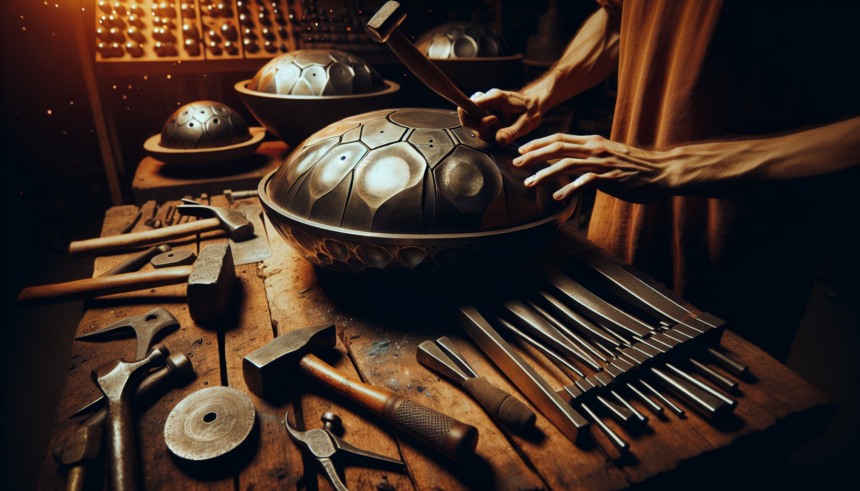The handpan, a unique and mesmerizing musical instrument, has captured the hearts of many musicians and music enthusiasts since its introduction. This article delves into the delicate art and craftsmanship of handpan makers who create these beautiful instruments. Their work is a perfect amalgamation of skill, dedication, and musical intuition, ensuring each handpan is a unique masterpiece.
To understand the intricacies involved in handpan creation, we must first take a closer look at the instrument itself. The handpan is a steel drum-like instrument, typically played with the hands, producing an ethereal, resonant sound. It consists of two metal hemispheres, usually made of nitrided steel, and features a central note surrounded by an array of other notes arranged in a circle. Handpans are tuned to specific scales and can have a varying number of notes depending on the maker’s design.
Creating a handpan is an intricate process that requires a blend of metallurgical skill, musical understanding, and artistic vision. It all begins with selecting the right metal. Most handpan makers use nitrided steel, a type of treated steel known for its durability and tonal qualities. This metal is first cut into circular sheets and then shaped into two hemispheres using a hydraulic press or by hand hammering.
Once the basic shape is achieved, the process of tuning begins. This is one of the most crucial and time-consuming stages of handpan making. Each note on the handpan must be meticulously crafted and tuned to precise frequencies. This involves a series of delicate hammering procedures to adjust the tension and curvature of the steel, which in turn affects the pitch and timbre of the notes. Experienced handpan makers can spend several hours or even days working on a single note, ensuring it resonates perfectly with the surrounding notes. Every handpan has to go through multiple tuning sessions, often involving a combination of electronic tuners and the maker’s trained ear, to achieve the desired sound quality.
The next step involves nitrocarburizing or nitriding the handpan, a thermochemical process that hardens the steel surface and enhances its corrosion resistance. This step not only improves the durability of the handpan but also contributes to its distinctive sound characteristics. After nitriding, the handpan undergoes further tuning to correct any changes in pitch that may have occurred during the process.
The final stage of handpan making is the finishing touches. This includes polishing the metal to achieve a smooth surface, adding decorative elements such as engravings or paint, and sometimes applying a protective coating. Some makers also incorporate unique design features, such as engraved patterns or custom colors, to give their handpans a distinctive aesthetic appeal.
The creation of a handpan is not merely a mechanical process; it is a form of art that requires a deep understanding of music theory, acoustics, and metallurgy. Handpan makers often have backgrounds in percussion or other musical instruments, and many are self-taught artisans who have spent years perfecting their craft. The best handpans are those in which the maker’s passion and musical intuition are evident, resulting in instruments that not only sound beautiful but also inspire a deep emotional connection with their players.
Handpan making is a constantly evolving art form, with makers continually experimenting with new materials, designs, and techniques. Innovations such as the use of stainless steel or other metal alloys, the introduction of hybrid scales, and the development of new tuning methods have expanded the possibilities of the handpan’s sound. Additionally, the growing popularity of the instrument has led to a thriving community of players and makers who share their knowledge, experiences, and innovations, further enriching the world of handpan music.
As with any art form, the value of a handpan lies not only in its craftsmanship but also in the emotions and experiences it evokes. For many players, the handpan is more than just an instrument; it is a source of meditation, healing, and self-expression. The ethereal sound of the handpan has a unique ability to calm the mind and soothe the soul, making it a popular choice for mindfulness practices, therapy, and relaxation.
In conclusion, the art and craftsmanship of handpan makers are a testament to the dedication, skill, and passion required to create these mesmerizing instruments. Each handpan is a labor of love, reflecting the maker’s deep understanding of music and metallurgy. The result is a unique and enchanting instrument that resonates with players and listeners alike, offering a profound and transformative musical experience.
Frequently Asked Questions
-
1. What is a handpan?
A handpan is a steel drum-like musical instrument played with the hands. It produces an ethereal, resonant sound and consists of two metal hemispheres with a central note and several surrounding notes.
-
2. How is a handpan made?
The creation of a handpan involves shaping steel into hemispheres, tuning the notes via meticulous hammering, nitrocarburizing for durability, and final finishing touches such as polishing and decorative elements.
-
3. What materials are used to make a handpan?
Handpans are typically made from nitrided steel due to its durability and tonal qualities. Some makers also experiment with stainless steel or other metal alloys.
-
4. How long does it take to make a handpan?
Creating a handpan is a time-consuming process that can take several weeks, depending on the maker’s skill and the complexity of the design. Tuning each note perfectly can take several hours or even days.
-
5. Why is the handpan popular in mindfulness practices and therapy?
The handpan’s ethereal sound has a calming effect that helps in meditation, relaxation, and therapy. Its ability to produce soothing and resonant tones makes it ideal for mindfulness practices and emotional healing.





